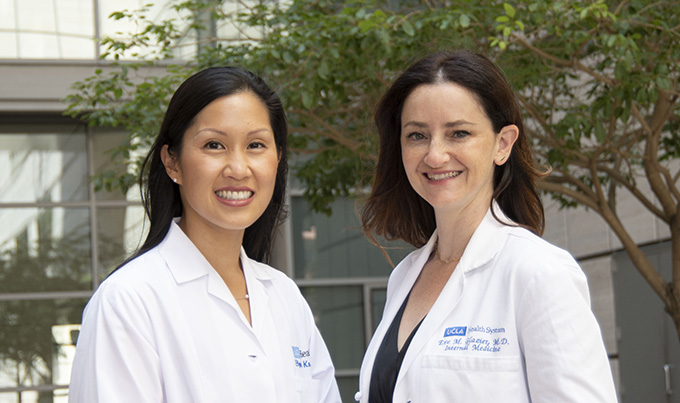(Ask the Doctors) Pollen counts are highest they’ve been in decades
Published 7:21 pm Tuesday, July 8, 2025

- Eve Glazier, M.D., MBA, is an internist and associate professor of medicine at UCLA Health. Elizabeth Ko, M.D., is an internist and assistant professor of medicine at UCLA Health. Send your questions to askthedoctors@mednet.ucla.edu.
Dear Doctors: I have hay fever, but usually it’s not that bad. This year, however, it has been awful. I’m plugged up, my eyes are itchy and by the end of the day, I have a headache. We live near Atlanta, and a lot of people here are miserable. Over-the-counter meds aren’t helping. What can I do?
Dear Reader: We suspect your body is responding to pollen, the powdery substance emitted by many plants, grasses and trees in the reproduction process. The National Allergy Bureau, an arm of the American Academy of Allergy, Asthma and Immunology, compiles daily readings of pollen counts. This spring, their data show the highest pollen counts recorded in decades in many regions of the United States.
The NAB maintains about 85 pollen counting stations across the U.S. Devices at each station capture pollen and mold spores, and they collect samples every 24 hours. They examine the samples under a microscope to get readings on the number of pollen grains per cubic meter of air. The higher the number, the more airborne pollen. According to NAB data, the Atlanta area is recording its highest pollen counts in 35 years.
Trending
Hay fever is the body’s response to this pollen. The medical term for this unique form of discomfort is allergic rhinitis. Breathing in pollen spores triggers the immune system to send out chemical messengers called histamines. These set off an inflammatory response meant to repel and kill the pollen invaders.
The congestion, itchy eyes and headache you have are common symptoms of hay fever. Other symptoms can include sneezing, post-nasal drip, watery eyes, coughing, wheezing, shortness of breath, sore throat and fatigue. Many people with allergic rhinitis get relief from over-the-counter antihistamines. Although they can be helpful, it is possible to build up a tolerance to their effects. Immunotherapies, such as allergy shots or tablets, are also an option.
This year’s pollen counts can even bother people who don’t have allergies. This is known as nonallergic rhinitis. Antihistamines are not effective for people with nonallergic rhinitis because histamines don’t cause their symptoms. They can try over-the-counter decongestants. A saline sinus rinse to wash away spores can also help. Always use distilled or sterilized water in sinus rinse, as bacteria can be present in tap water.
Pollen counts are highest in the morning, at night and when it’s windy. Taking medication before heading out at those times can get ahead of symptoms. A good mask can provide a physical barrier. Pollen spores cling to surfaces, including skin, hair and clothes. A shower before bed and washing clothes thoroughly can also limit exposure. If severe symptoms persist, check in with your doctor about other options, such as prescription medications.
Dear Doctors: I want to know more about how exercising gives you a better chance of recovering from colon cancer. I’ve been trying to help my brother-in-law, who just got diagnosed. He doesn’t exercise, and I hope this might motivate him. He’s only 42, and we are all surprised by this diagnosis.
Dear Reader: It’s estimated around 153,000 people in the United States will be diagnosed with colorectal cancer this year. The incidence rate of these types of cancers is 33% higher in men than women. The age of diagnosis has also steadily dropped. Usually seen in older adults, this disease is getting more common in people under age 50. According to the American Cancer Society, cases of colorectal cancer in people under 55 have doubled from 10% of all diagnosed cases in 1995 to 20% in 2019.
Trending
With the age of diagnosis trending younger, it’s now recommended that screenings start at age 45. For those at average risk of the disease, fecal sample screening may be an option. People with a family history of the disease may be screened before 45 with a colonoscopy.
The reasons for this spike in younger adults are not yet clear. Lifestyle factors seem to play a key role, such as poor diet, lack of exercise, smoking, alcohol use and excess weight. A family history of the disease or certain inherited genetic conditions can be a risk factor. Chronic conditions that contribute to gut inflammation may also contribute. Researchers are looking at the use of antibiotics as another possible factor.
We believe your question refers to the findings of new research recently published in the New England Journal of Medicine. The study followed 889 people over 15 years, starting in 2009. Participants had completed chemotherapy for colon cancer characterized as “treatable.” The study divided participants into two groups. One group received detailed information about the importance of exercise and nutrition. The second group had three years of a structured exercise program with a trainer. For many, the program was as simple as a brisk 45-minute walk three or four times a week.
The guided exercise group had measurably higher survival rates than the information-only group. After eight years, overall survival in the exercise group was 90.3%, and 83.2% in the information-only group. This tells us two important things: First, when caught early enough for treatment, colon cancer survival rates are very high. And second, the whole point of the study — adding a regular exercise program can boost survival rates even further.
Eve Glazier, M.D., MBA, is an internist and associate professor of medicine at UCLA Health. Elizabeth Ko, M.D., is an internist and assistant professor of medicine at UCLA Health.




